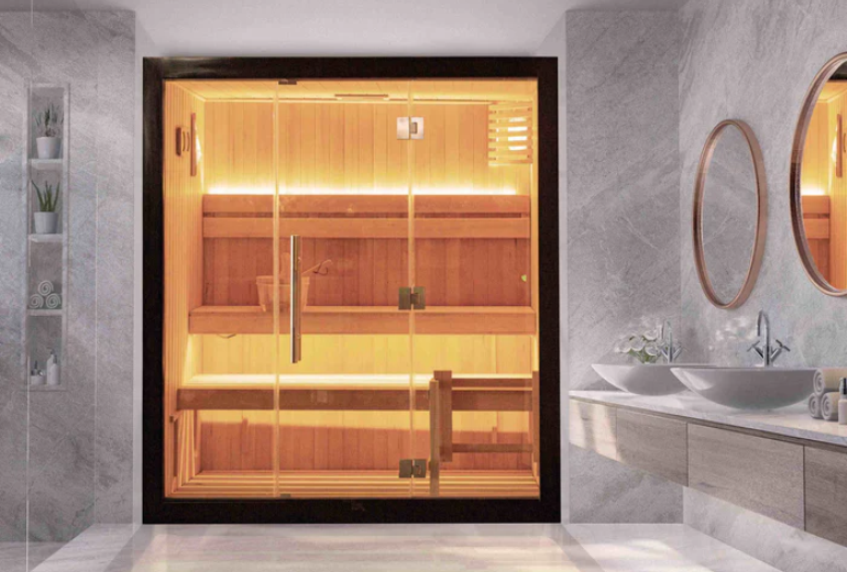Health
Barrel Saunas: Combining Tradition with Modern Efficiency

Barrel saunas represent a harmonious blend of ancient wellness practices and contemporary design, offering a unique experience that caters to both traditional enthusiasts and modern users. These saunas are deeply rooted in the rich history of Finnish sauna culture, where the practice of heat bathing has been cherished for centuries for its health benefits and communal aspects. Today, barrel saunas bring this tradition into the modern era with advanced materials, efficient heating systems, and stylish aesthetics, making them a popular choice for a wide range of users. Whether installed in a backyard or integrated into a home, barrel saunas from We Are Sauna provide an unparalleled blend of tradition and innovation. We recommend you to learn more about 4 person barrel saunas or 4 person indoor saunas here.
Historical Roots and Modern Appeal
The origins of sauna use can be traced back to ancient Finland, where saunas were central to daily life and community gatherings. These traditional saunas were typically built from logs and heated by wood-burning stoves, creating a warm, inviting atmosphere that promoted relaxation and health. The barrel sauna design, with its distinctive cylindrical shape, pays homage to this heritage while incorporating modern efficiency. This shape not only maximizes interior space but also enhances heat circulation, allowing the sauna to heat up quickly and maintain consistent temperatures with minimal energy use. The fusion of historical design with contemporary efficiency makes barrel saunas a perfect example of how traditional practices can evolve to meet modern needs.
We Are Sauna has perfected this balance, creating barrel saunas that offer both aesthetic appeal and functional benefits. The use of high-quality, sustainably sourced wood such as cedar and spruce ensures durability and a natural, rustic charm. These materials are chosen not only for their visual appeal but also for their excellent thermal properties, which help maintain the sauna’s internal climate. This attention to detail in both design and material selection highlights how barrel saunas bridge the gap between past and present, providing a timeless wellness experience that fits seamlessly into contemporary lifestyles.
Key Features and Efficiency
The unique design of barrel saunas is not merely for aesthetic purposes; it also significantly enhances their functionality. The cylindrical shape of the sauna reduces the volume of air that needs to be heated, making it more energy-efficient compared to traditional rectangular designs. This efficiency translates to faster heating times and lower operating costs, making barrel saunas an eco-friendly choice for environmentally conscious users. Additionally, the compact footprint of a barrel sauna allows it to be installed in smaller spaces, making it an ideal option for urban dwellers with limited outdoor areas.
Modern barrel saunas from We Are Sauna are equipped with state-of-the-art heating systems that can be customized to suit individual preferences. Whether using traditional wood-burning stoves or contemporary electric heaters, these systems ensure a consistent and comfortable sauna experience. Advanced features such as digital controls and programmable settings offer users precise control over temperature and session duration, enhancing convenience and user satisfaction. The combination of traditional sauna benefits with modern efficiency and customization options makes barrel saunas an attractive addition to any wellness routine.
Health Benefits and Expert Endorsements
The health benefits of regular sauna use are well-supported by scientific research and expert endorsements. Dr. Jari Laukkanen, a leading researcher in cardiovascular health, has highlighted the positive impact of sauna bathing on heart health, including improved circulation, reduced blood pressure, and decreased risk of cardiovascular disease. The intense heat of the sauna promotes sweating, which helps to detoxify the body by flushing out toxins and impurities. This process not only cleanses the skin but also supports overall immune function. Regular sauna sessions have also been shown to alleviate muscle soreness, improve joint mobility, and enhance mental clarity.
Mental health benefits are equally significant, with many users reporting reduced stress and improved sleep quality after regular sauna use. Dr. Rhonda Patrick, a health and wellness expert, notes that the heat exposure in saunas can stimulate the production of endorphins, the body’s natural “feel-good” chemicals, leading to enhanced mood and relaxation. These benefits are amplified by the serene and meditative environment of a barrel sauna, providing a holistic approach to wellness that addresses both physical and mental health. The endorsement of health experts further underscores the value of incorporating a barrel sauna into a regular wellness routine.
User Testimonials and Real-Life Experiences
Real-life experiences from users of We Are Sauna’s barrel saunas highlight the transformative impact of these wellness retreats. Jane and Mark Thompson, homeowners who installed a barrel sauna in their backyard, share their positive experience: “Our barrel sauna has become an integral part of our daily routine. The design is not only beautiful but incredibly efficient. We feel rejuvenated after each session and have noticed significant improvements in our overall health.” Such testimonials reflect the widespread satisfaction and health benefits that users enjoy, making barrel saunas a valuable investment for any home.
Other users have praised the ease of installation and maintenance of these saunas. Mark Anderson, who set up his barrel sauna on a small deck, mentions, “The assembly process was straightforward, and the quality of the materials is evident. It’s a low-maintenance addition that provides high benefits. We’ve recommended it to all our friends.” These real-life stories illustrate how We Are Sauna’s barrel saunas can seamlessly integrate into various living spaces, offering both practical and wellness advantages. The combination of positive user experiences and expert endorsements underscores the appeal of barrel saunas as a holistic wellness solution.
Embrace Tradition and Modernity with We Are Sauna
Barrel saunas from We Are Sauna encapsulate the perfect blend of traditional sauna practices and modern efficiency. Their unique design, efficient heating systems, and high-quality materials make them a standout choice for anyone looking to enhance their wellness routine. The health benefits of regular sauna use, supported by scientific research and user testimonials, highlight the value of investing in a barrel sauna. Whether you have a spacious backyard or a compact urban patio, these saunas offer a versatile and luxurious wellness retreat that fits seamlessly into any lifestyle. Experience the luxury and health benefits of owning a barrel sauna from We Are Sauna, and enjoy a timeless tradition adapted for the modern age.
Health
WHO Warns of Sharp Rise in Mental Health Conditions Among Europe’s Youth

A growing number of children and teenagers across Europe are experiencing mental health conditions, with global health officials warning that support systems are failing to keep pace with the surge. A new analysis released by the World Health Organization (WHO) outlines the scale of the challenge and calls for urgent action across the region.
According to the report, one in seven Europeans under the age of 20 are living with a mental health condition — a rise of about one-third over the past 15 years. The findings show clear gender disparities, with girls facing greater vulnerability. Among girls aged 15 to 19, one in four report having a mental health condition, making them the most affected group.
The report also highlights striking differences between countries. Teenagers in the Faroe Islands, Iceland and Denmark ranked among the highest for mental wellbeing, while those in Ukraine, Cyprus and Poland were placed at the lower end of the scale. The data reflects both long-term trends and the impact of recent crises.
Concerns about youth mental health have intensified in recent years, driven by a combination of social isolation, the effects of the COVID-19 pandemic, geopolitical tensions and growing economic pressures. Experts say these factors have created an environment in which young people are increasingly exposed to stress and uncertainty.
Access to professional support remains one of the region’s biggest obstacles. The WHO report notes that about one-quarter of European countries do not have community-based mental health services for young people. In addition, one in five countries lack dedicated mental health policies, leaving many children and teenagers without structured pathways to receive help.
“This report is a wake-up call,” said Dr. João Breda, who works on patient safety and healthcare quality at the WHO. “Every child and young person has the right to mental health support and high-quality care.”
The findings mark the first time the WHO has compiled extensive data on child and youth mental health across its European region, which includes 53 countries in Europe and Central Asia. The report stresses the need for stronger in-person care, noting rising concerns about young people turning to digital tools for emotional support. The document raises alarms about cases in which reliance on artificial intelligence chatbots, including ChatGPT, has led to harmful outcomes.
The WHO is urging governments to strengthen their mental health frameworks by increasing investment, expanding services and updating programmes to better reflect the needs of children and adolescents.
“By acting now, countries can build resilient systems that help the next generations thrive,” Breda said.
Health
Poliovirus Detected in Hamburg Wastewater, Raising Public Health Alerts

Health authorities in Germany have discovered traces of the poliovirus in sewage from Hamburg, highlighting a persistent health threat decades after Europe was declared polio-free. The finding has prompted renewed calls for enhanced disease monitoring and vaccination coverage.
Germany has not reported any confirmed cases of poliomyelitis, a highly contagious disease that primarily affects young children and can invade the nervous system, sometimes causing paralysis. The poliovirus detected in Hamburg’s wastewater is genetically similar to a strain last identified in Afghanistan, one of only two countries where polio remains endemic.
The European Centre for Disease Prevention and Control (ECDC) described the detection as “unusual, but not unexpected.” Germany’s last known locally transmitted polio case occurred in 1990, and the continent was officially declared polio-free in 2002. However, health officials caution that imported cases remain possible, particularly among populations with low vaccination coverage.
The World Health Organization (WHO) emphasized that the discovery underscores the ongoing risk: “Until polio is eradicated everywhere, all countries remain at risk of importation of the virus and potential re-infection.” Poliovirus can appear in sewage when individuals shed the virus in their stool. This does not necessarily indicate illness, as it can also result from people receiving the oral polio vaccine, which contains a weakened live virus.
Last year, similar detections in Germany, Poland, and Spain prompted health authorities to urge countries to strengthen surveillance systems and vaccination campaigns to protect populations from potential outbreaks. Across the European Union, vaccination coverage among one-year-olds ranged from 79 percent in Romania to 99 percent in Hungary and Luxembourg, according to WHO data. Experts note that gaps may persist at the local level, leaving some communities vulnerable to transmission.
Despite the presence of the virus in sewage, the ECDC stressed that the overall risk to the European population remains “very low.” Health authorities are using the findings to monitor trends and reinforce vaccination messaging, particularly in areas where immunization rates fall below recommended levels.
Germany’s recent detection serves as a reminder that polio, although rare in Europe, has not been fully eliminated globally. Public health officials continue to advocate for robust immunization programs, vigilant disease surveillance, and rapid response plans to prevent the virus from spreading should a case arise.
The Hamburg wastewater discovery has renewed focus on the importance of vaccination and monitoring, reinforcing global efforts to ensure that polio remains under control until it is eradicated worldwide.
Health
Scientists Explore New Frontiers in Autoimmune Disease Research as Cases Rise Worldwide

Scientists are still investigating potential causes and treatments for autoimmune conditions. Here’s what to know. Autoimmune diseases, which occur when the body’s defense system mistakenly attacks its own cells, now affect tens of millions of people globally. These conditions can strike nearly any part of the body and are most common among women, though men and children are not exempt. Rates have been climbing for years, raising urgent questions about how the immune system goes awry and how to better diagnose and treat these illnesses.
Researchers say progress in understanding the immune system is opening doors to new therapies that may go beyond controlling symptoms. “This is probably the most exciting time that we’ve ever had to be in autoimmunity,” said Dr Amit Saxena, a rheumatologist at NYU Langone Health in the United States. His optimism reflects a growing scientific push to reprogramme faulty immune responses rather than only suppress them.
Scientists have pinpointed a potential driver of the global rise in colon and rectal cancers among young people: ultra-processed foods. Women who ate the most ultra-processed foods had a higher risk of developing polyps that can lead to cancer compared with women who ate the least. The finding adds urgency to research into immune-related disorders, many of which appear to be influenced by environmental triggers.
More than 100 autoimmune diseases have been identified. Rheumatoid arthritis and psoriatic arthritis inflame joints. Sjögren’s disease is known for dry eyes and mouth. Myositis and myasthenia gravis weaken muscles, while lupus can attack organs ranging from the kidneys to the heart. Symptoms often ebb and flow unpredictably, with patients experiencing long periods of stability before suddenly facing a flare.
Diagnosing these conditions is notoriously difficult. Early signs are often vague, overlap with other illnesses, or appear sporadically. Doctors may order blood tests to search for misplaced antibodies, yet many patients spend years seeking answers from multiple specialists. Efforts to speed diagnoses are underway, including updated guidance for detecting multiple sclerosis.
Scientists are also studying how the immune system becomes confused. Normally, it distinguishes foreign threats from the body’s own tissues. When that tolerance breaks down, chronic disease can develop. Genetics can increase vulnerability, but usually an external trigger — infection, smoking, pollutants — is needed to set the process in motion. New evidence links the Epstein-Barr virus not only to multiple sclerosis but also to lupus, offering fresh insight into how hidden viral infections may spark long-term immune disruption.
Women face the highest risk of autoimmune disease, possibly due to hormonal influences or differences linked to the X chromosome. Some conditions, however, overwhelmingly affect men. VEXAS syndrome, discovered in 2020, typically strikes men over 50 with severe symptoms that include breathing problems and blood clots.
Treating autoimmune diseases remains complex. The global market for therapies exceeds $100 billion (€87 billion) annually, yet many patients still navigate trial-and-error treatment plans. While high-dose steroids and broad immune-suppressing drugs were once the main options, newer treatments now target specific molecules. The most promising new approach involves CAR-T therapy — originally developed for cancer — which wipes out malfunctioning immune cells and allows healthier ones to grow back. Early trials show potential benefits for lupus, myositis, and other conditions.
Scientists hope that continued research will bring earlier detection, better tools to prevent disease onset, and therapies that address root causes rather than symptoms.
-

 Entertainment1 year ago
Entertainment1 year agoMeta Acquires Tilda Swinton VR Doc ‘Impulse: Playing With Reality’
-

 Business1 year ago
Business1 year agoSaudi Arabia’s Model for Sustainable Aviation Practices
-

 Business1 year ago
Business1 year agoRecent Developments in Small Business Taxes
-

 Home Improvement12 months ago
Home Improvement12 months agoEffective Drain Cleaning: A Key to a Healthy Plumbing System
-

 Politics1 year ago
Politics1 year agoWho was Ebrahim Raisi and his status in Iranian Politics?
-

 Business1 year ago
Business1 year agoCarrectly: Revolutionizing Car Care in Chicago
-

 Business1 year ago
Business1 year agoSaudi Arabia: Foreign Direct Investment Rises by 5.6% in Q1
-

 Sports1 year ago
Sports1 year agoKeely Hodgkinson Wins Britain’s First Athletics Gold at Paris Olympics in 800m


























